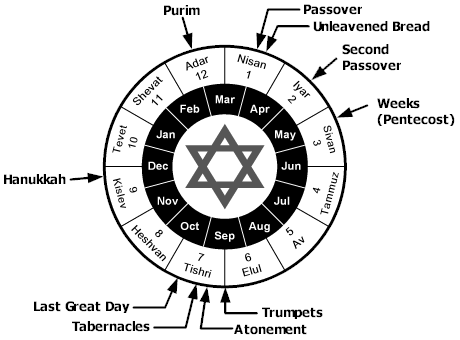THE LORDS FEASTS
SABBATH – Shabbot, Saturday, 7th Day of Week
In Genesis 1:14 Yahweh declared that these astronomical bodies which cannot be controlled or manipulated by man were the authority in declaring when the Moeds or festivals /appointments were to be kept. They are God’s default program where there is no human authority.
PASSOVER – NISSAN 14 – Leviticus 23:5 * It is not a “no work” holiday. It celebrates the Hebrews exodus from Egypt. Pesach is pronounced “Pay sock”. The final plaque of death of the ‘first born’ passed over their homes when the blood of the lamb was spread over their doorposts. The ‘Seder’ service recounts the story of Passover.
FEAST OF UNLEAVEN BREAD – Lev 23:6-8 * Begins Nisan 15 and lasts seven days. The first and last days are Holy Convocations in which no work is permitted: Nisan 15 and Nisan 21. During the Feast of Unleavened Bread no food with leaven is eaten. It commemorates the unleavened bread the Israelites took with them when they were freed from bondage in Egypt. In the days leading up to Passover and the Feast of Unleavened Bread Jewish families clean their homes of any leaven so as not to cause defilement during the feast. The unleavened bread eaten during the feast is called ‘Matzo.’
FEAST OF FIRST FRUITS – Lev 23:10-14 This feast celebrates the barley harvest which begins in the month of Nisan. It was required to bring the first sheaf of their harvest to the Temple as a wave offering. This feast begins the counting of the Omer leading up to Shavuot. Lev 23:11 says to bring the wave offering on the day after the Sabbath so we know Firstfruits is always on a Sunday.
SHAVOUT – 50TH Day Counting of Omer – SIVAN 6 * Leviticus 23:15-21. Shavuot is pronounced like “Shaw-voo-oat”. It is to take place seven Shabbaths and one day or fifty days total from Fruitfruits. Shavuot means “weeks” and is often called Pentecost which means ‘fifty’ in Greek. It is a harvest festival in which the Israelites were to present an offering of new grain (in this case wheat) to the Lord in the Temple. It is believed that Moses received the Torah on Mount Sinai on Shavuot. We also see the Day of Pentecost that the Holy Spirit fell on many disciples with tongues of fire. It is celebrated in Israel by reading the account of the giving of the Law in Exodus 19 and 20. The book of Ruth is also read because it is a book of harvest and redemption. It is customary to eat dairy foods like cheese during Shavuot.
ROSH HASHANAH – Lev 23:24-25 * TISHREI 1 and 2 * Head of Year * Shofar blown 100 times * Also known as Yom Teruah which means “Day of Blowing” and is commonly known as the Jewish New Year. The pattern is repeated eleven times for a total of ninety-nine blasts. The last blast is set apart and is known as the “Last Trump”. Thus, also known as Feast of Trumpets. The time of Jacobs Trouble” is referenced in Jer. 30:6,7 and Zeph 1:14-16. ‘Day of Awakening Blast’ is referenced in Isaiah 26:19 and I Thess 4:16, 17. Opening of Books as in Daniel 7:10. Custom teaches it is on this day the Heavenly court sin session every year. This begins “10 Days of Awe”. This leads up to Yom Kippur when the books are closed and final judgment is meted out. It lasts two days and is referred to as one long day. Round challah is eaten that symbolizes a crown that reflects our coronating God as the King of the world. It is custom to greet others by saying L’shanah tovah meaning “for a good year”. Rosh Hoshannah is a Holy Convocation in which NO work is permitted.
YOM KIPPUR/DAY OF ATONEMENT – Lev 23:26, 27. It begins the eve of Tishri 9 and is called ‘The Fast’ on the 10th day of Tishrei. During the “Days of Awe” you seek reconciliation for sins against another person, which must be done before Yom Kippur. Yom Kippur is for atonement between you and Yahweh. Yom Kippur is the day of atonement for the nation of Israel and was the only day the High Priest could enter the Holy of Holies. It is a Holy Convocation in which no work is permitted. It is also a fast day. It is a complete 25-hour fast that begins sunset on the evening before Yom Kippur and ends after sunset on the day of Yom Kippur. It is customary to wear white to symbolize purity and cleanness from sin.
FEAST OF TABERNACLES – Sukkot: Booth * Lev 23:39-42a * TISHREI 15-22 * It would begin the evening of 14 Tishrei and go through 22 Tishrei. Succot lasts seven days. But, one more day is added called ‘Sh’mini Atzeretz’ (Eighth Day) also known as Simchat Torah (Rejoicing in the Torah.)
The first and eighth days are Holy Convocations in which no work is permitted: Tishrei 15 and Tishrei 22. We dwell in ‘booths’ or ‘temporary dwelling place’ or a sukkah for seven days. It should have at least two and one-half walls that will not blow away in the wind and traditionally should be able to see the stars through the ceiling. It is decorated with The Four Species (Lev. 23:40) which are also known as the Lu lav and Etrog. An Etrog (a citrus fruit native to Israel,similar to a lemon), a palm branch, two willow branches and three myrtle branches. The six branches are bound together and are referred to as the Lu lav. While holding the four species a blessing is said and the species is waved in six directions, East, South, West, North, Up and Down to symbolize God being everywhere.
Some information is taken from El Shaddai Ministries 2013 calendar.

